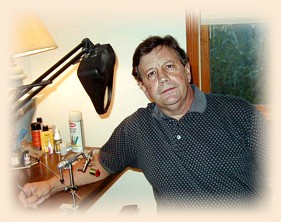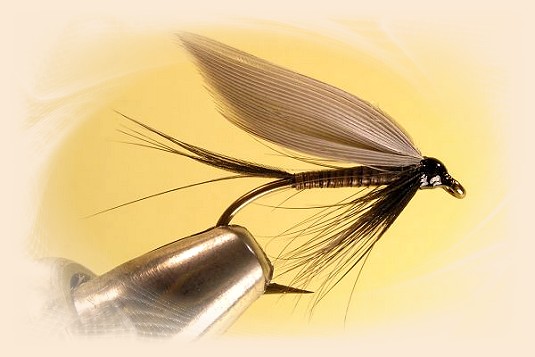I've got just one more quill body fly to show this week,
as well as some observations about Ray Bergman. For some
time I've wondered about the wet fly illustrations shown
in Bergman's Trout. Each of these flies are
quite perfect, with heads that are nearly unachievable with
some of the flies, each appearing to be the same size, one
after the other, in cookie cutter fashion. Now I knew Ray
Bergman was a first rate tier, but were these flies actually
representative of the flies he tied and fished on a regular
basis? I thought not, and pictures of flies actually tied by
Ray Bergman bear this out.
They were printed in Outdoor Life magazine in 1950,
the publication for which Bergman wrote for a number of years.
Two pages of flies, one of wets and one of dries are shown on
classictrout.com, in the "Classic Remembrance" section. They
dispel some illusions that we tiers may have had about the
"Bergman" wet flies, which of course were no more Ray Bergman's
than anyone else's, and serve to reinforce the notion of Ray
Bergman as fisherman, rather than that of Ray Bergman, pretty
fly tier.
In short, Ray Bergman's actual wet flies are somewhat different
than those shown in the Dr. Burke illustrations. They are "buggier,"
i.e., not as clean and antiseptic looking, with somewhat bushier
tails and hackles. They look "fishier." The hackles on all flies
are not pulled neatly down, and on some go almost 360 degrees
around. The sizes vary a great deal, and the proportions do
somewhat as well. The majority of the wings don't extend much
beyond the bend of the hook, not half way down the tail as is
commonly thought. The bodies vary from fly to fly, sometimes
showing a lot of taper, with a bulging thorax, sometimes having
no perceptible taper at all. Even though Bergman says in
Trout, "For wet flies, place the two even and
concave edges together, with the tips pointing inward and
touching each other," literally half the wets are tied with
their tips apart. The most dramatic difference between Ray
Bergman's actual flies and the idealized illustrations in
Trout is found with the heads. While we have
all been working very hard to get hemispherical, perfectly
polished heads, as shown in the book, Ray Bergman appears to
not have been concerned with this in the least. He was a
fisherman after all, and these flies were tied for fishing.
Some exhibit the "cliff" that occurs when you cut the wing
butts off flush after tying them on and then wrap all the
way down to the eye and back. There does not appear to be
black lacquer used, in fact, there well not have been any
glue used at all. If there was, it was head cement at best.
These are not, by today's standards, pretty heads, though
they are neat and fairly small. As a rule they are more
elongated than those shown us by Dr. Burke. Some DO look
like the ones in the book however, and this says to me that
we all have our ideal vision of a fly, but none of us achieves
it every time out.
One other thing that must be said here is that Trout
was written in 1938, and the Outdoor Life photos appeared
in 1950. A lot of ideas about tying can change in 12 years. What
I take away from this has a lot to do with the way I've always
thought about Ray Bergman, that he was a fisherman first, and
a great one. I can't imagine Ray Bergman or Lee Wulff spending
a lot of time over a fly. They would be much more concerned
with imitating what was going on at a particular time on a
stream, throwing some flies together in the evening for the
next day, as we all do. Many of us, myself included, have
exalted these flies to a status never conceived of by Ray Bergman,
and that's fine. I tie one sort of fly for show, and one sort of
fly for fishing, and there is nothing wrong with that, many of us
do it. As far as Dr. Burke's illustrations are concerned, there
is nothing inherently wrong with them either. He was attempting
to illustrate exactly the colors and textures of the real flies,
in an instructional way, not unlike the illustrations done in
Kelson's The Salmon Fly. Neither set of
illustrations do a very good job of showing how the fly actually
looked, when tied for fishing, but do a perfect job of showing
exactly what materials were used, and how they went together.
As far as the Black Quill is concerned, think Blue Quill with
black hackle instead of dun. It's a great early season fly,
wet or dry. Here's the recipe:
Credits: Trout by Ray Bergman,
classictrout.com by J.B. and Chris Martin ~ EA
About Eric:
 I started fly fishing as a teen in and around my hometown
of Plattsburgh, New York, primarily on the Saranac River.
I started tying flies almost immediately and spent hours
with library books written by Ray Bergman, Art Lee, and
A. J. McClane. Almost from the beginning I liked tying
just as much as I liked fishing and spent considerable
time at the vise creating hideous monstrosities that
somehow caught fish anyway. Then one day I came upon a
group of flies that had been put out at a local drug store
that had been tied by Francis Betters of Wilmington, N.Y.
My life changed that day and so did my flies, dramatically.
Even though I never met Fran back then, I've always
considered him to be one of my biggest influences.
I started fly fishing as a teen in and around my hometown
of Plattsburgh, New York, primarily on the Saranac River.
I started tying flies almost immediately and spent hours
with library books written by Ray Bergman, Art Lee, and
A. J. McClane. Almost from the beginning I liked tying
just as much as I liked fishing and spent considerable
time at the vise creating hideous monstrosities that
somehow caught fish anyway. Then one day I came upon a
group of flies that had been put out at a local drug store
that had been tied by Francis Betters of Wilmington, N.Y.
My life changed that day and so did my flies, dramatically.
Even though I never met Fran back then, I've always
considered him to be one of my biggest influences.
I had a career in music for twenty years or so and didn't
fish much, though I did fish at times. The band I was with
had its fifteen seconds of fame when we were asked to be in
John Mellencamp's movie "Falling From Grace." I am the
keyboard player on the right in the country club scene in
the middle of the movie. Don't blink. It's on HBO all the
time. We got to meet big Hollywood stars and record in John's
studio. It was a blast.
So how did I wind up contributing to the Just Old Flies
column on FAOL? I'm not sure, it was something that I simply
wanted very badly to do, and they let me. Many of the old flies
take me back to the Adirondacs and my youth, and I guess I get
to relive some of it through the column. I've spent many happy
hours fishing and tying over the years, and tying these flies
brings back memories of great days on the water, and intense
hours spent looking at the flies in the fly plates in the old
books and trying to get my flies to look like them. And now,
here I am, still doing that to this day. ~ EA
|


 I started fly fishing as a teen in and around my hometown
of Plattsburgh, New York, primarily on the Saranac River.
I started tying flies almost immediately and spent hours
with library books written by Ray Bergman, Art Lee, and
A. J. McClane. Almost from the beginning I liked tying
just as much as I liked fishing and spent considerable
time at the vise creating hideous monstrosities that
somehow caught fish anyway. Then one day I came upon a
group of flies that had been put out at a local drug store
that had been tied by Francis Betters of Wilmington, N.Y.
My life changed that day and so did my flies, dramatically.
Even though I never met Fran back then, I've always
considered him to be one of my biggest influences.
I started fly fishing as a teen in and around my hometown
of Plattsburgh, New York, primarily on the Saranac River.
I started tying flies almost immediately and spent hours
with library books written by Ray Bergman, Art Lee, and
A. J. McClane. Almost from the beginning I liked tying
just as much as I liked fishing and spent considerable
time at the vise creating hideous monstrosities that
somehow caught fish anyway. Then one day I came upon a
group of flies that had been put out at a local drug store
that had been tied by Francis Betters of Wilmington, N.Y.
My life changed that day and so did my flies, dramatically.
Even though I never met Fran back then, I've always
considered him to be one of my biggest influences.